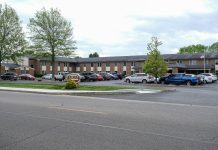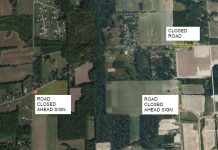At least two new sites will be utilized by Exhibit Columbus’ five Miller Prize winners to build temporary architectural installations by August 2019. They are Columbus City Hall and the lawn around both the Bartholomew County Memorials For Veterans and the Bartholomew County Courthouse.
Those new locale details emerged from the final presentation at Saturday’s close of The National Symposium: Design, Community and Progressive Preservation at The Commons downtown before about 250 people. At separate presentations earlier, the crowd peaked at about 350 people, organizers said.
Overall, including a free street concert following the closing event, the four-day symposium attracted an estimated 1,200 people, organizers said. That’s slightly more than last year’s estimated 1,000 people.
The Bartholomew County Public Library Plaza and Central Middle School so far are the only sites repeating from last year’s highly popular exhibition, one that drew an estimated 50,000 people over three months, highlighting a wealth of creativity and whimsy.
[sc:text-divider text-divider-title=”Story continues below gallery” ]
One site is still to be decided.
Prize winners Gina Ford and Brie Hensold of Landscape + Planning of Cambridge, Massachusetts, said she hoped to land a spot at a favorite structure — the AT&T Switching Center building at 422 Seventh St. downtown.
“It’s interesting physically in that it’s reflective, and that it has this trellis,” Ford said. “And from a landscape perspective, we could definitely think of some interesting things to do.”
However, Exhibit Columbus organizers said the fifth and final site will not be decided for a few more weeks. The final spot could end up being Mill Race Park or North Christian Church.
Mill Race was a Miller Prize site last year, and North Christian was part of the university installations, as was Central Middle School.
Miller Prize Winners will return to the city for their general presentations and plans at a public meeting Jan. 19 at The Commons, said Richard McCoy, director of Landmark Columbus, the umbrella agency for Exhibit Columbus, which highlights art, architecture and design.
All winners able to attend said after their Saturday speeches that they were excited to get to work. Frida Escobedo of Frida Escobedo Studio in Mexico City, Mexico, could not make it to Columbus for her background presentation.
Here is the lineup for the installations:
The Bartholomew County Library Plaza: Frida Escobedo Studio, Mexico City, Mexico.
Columbus City Hall: Bryony Roberts Studio of New York, New York.
Central Middle School: MASS Design Group of Boston, Massachusetts, and Kigali, Rwanda.
Bartholomew County Memorial For Veterans and the Bartholomew County Courthouse lawn: SO-IL of New York, New York.
Each Miller Prize team gets $70,000 to design and build a temporary architectural creation to complement one of the five downtown structures.
Social justice and societal responsibility, which were national and international hallmarks of late Columbus leaders J. Irwin and Xenia Miller, for whom the awards are named, formed a strong theme of the session’s presentations.
“Absolutely (that’s on purpose),” McCoy said afterward. “We are in every way possible aligning the Miller Prizes with the tenets of the Miller family.”
As two prime examples, J. Irwin Miller was among organizers of the 1963 March on Washington during the Civil Rights Movement, and he also actively promoted women and minorities to positions of leadership at then-Cummins Engine Co. well before most corporations took up such matters.
Fitting that theme, landscape architect Ford kicked off the presentations with a photo of the October 1967 Esquire magazine cover of J. Irwin Miller and quoted from the story about Miller’s character and bent being a good mix for someone to be a candidate for president of the United States.
She quoted from Miller’s aspirations listed in the piece, including giving people a voice in matters of significance, and possessing a revolutionary passion, as important in both society and in design.
“Art sometimes very pointedly can be calling us to action,” Ford said.
Alan Ricks of the nonprofit MASS Design Group heavily highlighted his agency’s massive work in poor areas of Rwanda with such significant projects as an innovative hospital improving health recovery outcomes and nearby housing for physicians in order to better recruit doctors to the area. It also has specialized in design work in other low-income areas.
The company mission statement spotlights a goal “to research, build and advocate for architecture that promotes justice and human dignity.”
Ricks said he comes to the Central Middle School site initially with a lot of questions, including the best way to involve students.
“Hopefully, we will have a chance to come back and actually talk to the students before we present our actual proposal,” Ricks said.
Ball State University student Hoff Campbell was among attendees. He mentioned that he enjoyed hearing the different firms’ perspectives on the role and impact of design, especially MASS Design Group.
“I’ve always been a fan of their work — and the fact that they do projects focused on the betterment of things like health care and how architecture can appeal to that,” Campbell said.
[sc:pullout-title pullout-title=”The symposium by the numbers” ][sc:pullout-text-begin]
1,200: Estimated overall attendance
650: Registrants for the event
4: Days of conference
2: Number of years for the event
[sc:pullout-text-end]




